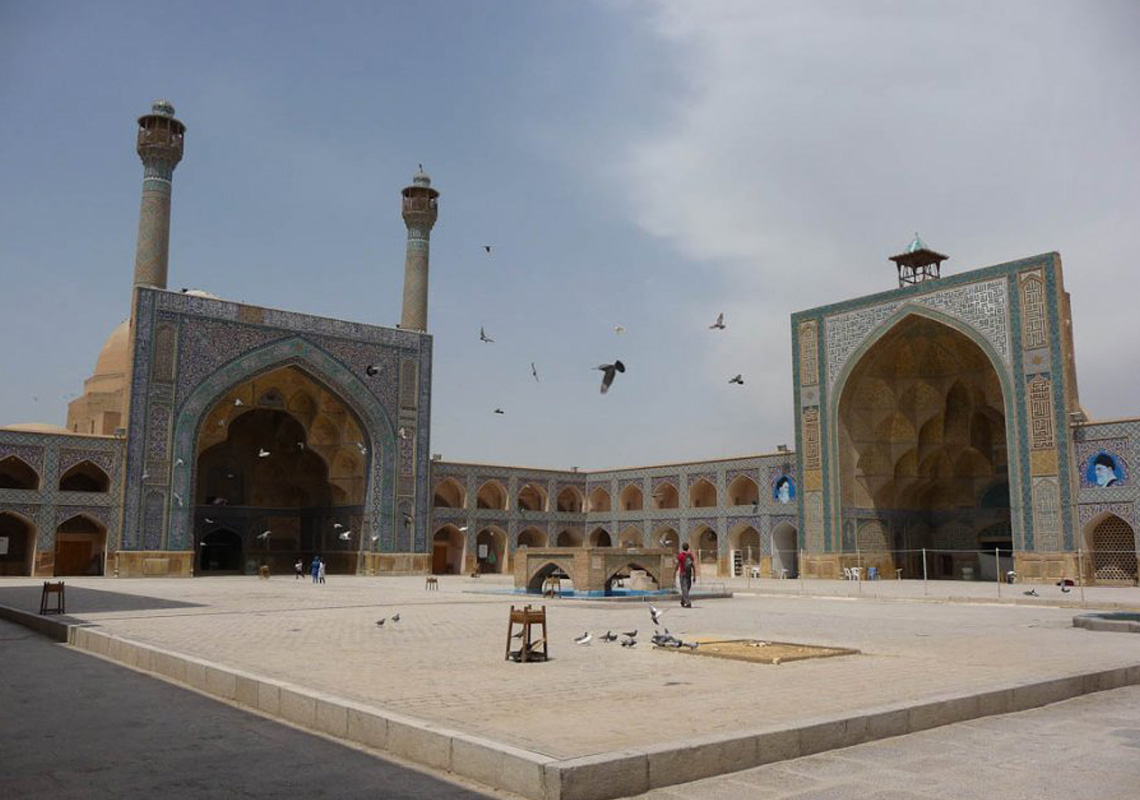This architect of this mosque was Master Mohammad Ali Esfahani. He started the construction in 4th century AH in Isfahan style. Hakim mosque is located in Iran, Isfahan, Esfahan, Hakim Street. This mosque is also known as Rangrazan main mosque.
Hakim mosque was built by the physician of Shah Abbas II at the site of the ruins of the ‘Jujir’ Mosque or the mosque of ‘Sahib Ismail bin Abad’. Calligraphy is done by Master Mohammad Reza Emami which adds an especial beauty to this monument
The door-head of this old mosque, which has been around for a thousand years, is considered as one of the first and foremost works of Islam. In addition to the shape and structure of the mosque, the mosque is famous for its exquisite and unique edges.
One of the most interesting and famous mosques in the Safavi era is the Hakim mosque in Isfahan. Its beautiful tiles and varied lines makes it one of the masterpieces of Islamic architecture in the work of well-known Masters and architectures of the Safavi era.
This magnificent mosque is located on the site of a mosque that was called ‘Jurjir’ during the reign of Delamian. This mosque was known as Rangrazan main mosque because it was at the end of the dye market. Rangrazan market means dying market. Using vast and vary colors in different industries were important in old Iran. For example; in most of old house in Iran or in another word in Traditional house in Iran, architectures paid a lot of attention about colorful designs.
Today, there is no trace left except the main Arc of the mosque. At the front of it, the differences between the surfaces were filled with a kind of plaster, which after the removal of them, the arc showed its interesting designs. This exquisite and magnificent courtyard is one of the first works of Islam. The Hakim Mosque was built during the reign of Shah Abbas II of Safavi. The reason behind the mosque being named as "Hakim" was that the founder of it was the "Mohammad Davood" who was a medical practitioner. That is why this mosque was called Hakim Davood mosque or Hakim mosque.
Historians and scholars who have studied and wrote about this person claim that: He was the physician of King Abbas II who was angered at him for some reason. In result he fled to India for fear of dying. As he grows in that land, some of his treatments for elders and princes were effective. His nicknamed as Taqarobkhan Khan and he earned a great deal of wealth. He sent some of this wealth to his relatives in Isfahan and asked them to build a magnificent mosque in Isfahan after his name.
This is how the Hakim mosque were built. The inscription on the north side of the mosque is on a white third line (Solce-Style) on the background of azure tiles which indicates that the inscription of this mosque is done by Mohammad Reza Emami the famous calligrapher of the Safavi era in 1073 AH. On either side of a small porch, with a white Nastaliq line on the azure background, you can see the name of Mohammad Ali bin Master Ali Beik Esfahani in beautiful and exquisite colors.
Inside the porch after some verses and phrases of holy Quran; the name of Mohammad Reza Emami and the date of 1069 has been written. Inscription on the altar is also done by Mohammad Reza Emami in 1071.
There are two sheets in the east and west dome of the Hakim mosque, written by Mohammad Reza Emami on the east and the calligraphy of the Western side is by Mohammad Baqir Shirazi.
The north porch of the mosque also contains very beautiful inscriptions around it. Holy Quran verses are written by Mohammad Reza Emami at 1071.
On the sides of the porch there are two small cells with poems written in simple three-lined masonry. In the west porch, verses from holy Quran with the name of Mohammad Reza Emami can be seen. The mosque of Hakim cell has a beautiful roof and is located on the west side. It has an exquisite and interesting altar with inscriptions written in excellent white third line (Solce). One of the reasons for the popularity of the Hakim Mosque, in addition to the overall structure of the mosque, which makes it one of the best historical buildings in Iran, is the interior architecture in the corners of Hakim mosque building.
Based on the studies done on the Hakim Mosque, it is clear that the dome and the cells of both sides of the Mosque were built in two quarters. The first phase completed in the Safavi era and the second phase happened during the post-Safavi time. With the construction of Hakim Street and the appearance of the western side of the mosque, the number of tourists who were visiting this unique building has increased and many enthusiasts are eager to visit it.
Hakim mosque is only 2.1 km away from Kianpour boutique hotel. Tourists at this historical house accommodation in Isfahan can take a walk, rent bike, call for a cab or use other types of public transportation in order to get there.







